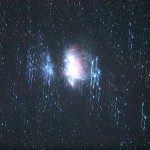It has been a while since the last good photographic comet. Since comet ISON disintegrated at perihelion a year ago, we have had few opportunities to get a really nice comet photo. It is the surprise of comet C/2014 Q2 Lovejoy that changed this.
Better yet… The comet is well placed for photography in the late evening and early morning sky. While fellow sky watchers on the south side of our planet have been enjoying the comet as it has brightened, for most northern hemisphere observers it is still rather low. In the past couple weeks it has moved far enough north that it is now nicely positioned to observe from Hawaiʻi. I have been following the comet for a while, catching it in binoculars from the house. We showed it to students of Paʻauilo Elementary in club telescopes as they camped out at the Kilohana Girl Scout Camp earlier this week.
Unfortunately it is still low enough that my neighbor’s trees prevent me from photographing it from the driveway. Thus I took the opportunity to pack up the ‘scope and head for Hale Pohaku and the Mauna Kea Visitor Information Station for a night of photography.
The Mauna Kea VIS is busier than ever, the numbers of tourists coming to this free show just continued to increase. Parking is now a major issue, with even the lower gravel lots full of visitor vehicles. Fortunately, with some discussion and name dropping, the rangers allowed me and my vehicle past the barricades into the main lot so I could set up just off the patio. I would be entertaining guests at the telescope and answering questions all evening, becoming part of the show.
I can just get the iOptron tripod into the vehicle without breaking it down. This way all of the various cables, power cords, power strips and a 12V power supply can remain zip tied to the tripod. This simplifies assembly a bit. It still took me over an hour to get everything reassembled, reconnected, polar aligned, focused and shooting. There are now multiple outlets available on the patio, lots of places to plug your telescope in.
Once set up and the computer screen was showing images the crowd of folks around my scope increased. for several hours, until the VIS closed, I had a circle of visitors around my setup asking questions and waiting for the images to appear. I just shot a couple showpiece objects to show the crowd, the Pleiades and M42, I was really waiting for the crowd to disappear and the comet to rise. I like to educate folks on the complexity of astrophotography, just how much work goes into a pretty image. The process is also quite similar to the methods used by professional astronomers… Auto-guiding, camera limitations, calibration frames and processing are same challenges faced by pros and amateurs alike. The conversation can be quite educational, with a little science slipped in.

I did have a fair amount of trouble with auto-guiding, it was necessary to futz with the parameters and the mount to get everything operating properly. I re-balance the mount with a little bias to the east, and adjusted PHD to allow larger moves.

After the VIS closed I invested some time to move the entire setup onto the patio just outside the main doors. This placed me and the scope out of the worst of the wind. Here conditions were much better, both me and the equipment spared the worst of the gusts. It took some time to get everything realigned, but the time was worth it, things ran much more smoothly in the shelter of the building.
While the computer and camera worked I took the opportunity to do a little binocular observing. I had brought the 9×63 binos for comet spotting, not thinking of using them for anything else. But I had failed to consider what I would be doing during the hour long exposure sequences. No problem, I had big binos and a dark sky.
I jumped from binocular object to object, M31, M42, NGC884 and NGC869, and more. I located fainter messier objects, attempting something more challenging, M1 is fairly easy at magnitude 8.4, M78 is likewise pretty easy, M79 is more difficult in binoculars due to its small size.
After midnight I noted a very bright glow to the south. The plume over the Kilauea caldera was lit up by the lava lake. The daily activity report from the USGS does not note any unusual activity at the summit. I expect that some small rockfall disrupted the crust exposing more of the bright orange lava and lighting up the plume of gasses.
I spent a couple hours acquiring images of the comet. With a four minute exposure the core is completely saturated, I took some shorter sets of subs at one minute and 15 seconds to properly expose the central coma. the autoguider was finally behaving itself at this point and tracking was nearly perfect.
My session was ended by the arrival of the Taikobo tour vans at 3:30am. With headlights, reverse lights and camera flashes destroying exposures and ruining my dark adaptation, I took the opportunity to break down the gear and head home. I had accomplished my goal for the night, plenty of comet images awaiting processing on the hard drive.


Great report
lookin forward to the images
aloha
I have not yet processed the final image. I did do some animations to watch the changes in the tail over two hours, those will post shortly!